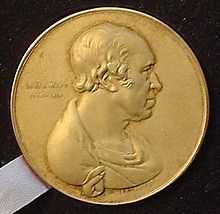James Watt International Medal
The James Watt Medal is the name of two awards named after Scottish engineer James Watt, both awarded for excellence in engineering:
James Watt International Gold Medal of the Institution of Mechanical Engineers
The James Watt International Gold Medal is awarded by the British to an outstanding mechanical engineer.
- "To commemorate the bicentenary of the birth of James Watt on 19 January 1736 - an event which was destined to bring about a revolution in the utilisation of power - the Institution of Mechanical Engineers award every two years a Gold Medal to an engineer of any nationality who is deemed worthy of the highest award the Institution can bestow and that a mechanical engineer can receive. In making the award, the Institution has sought the co-operation and advice of engineering Institutions and Societies in all parts of the world.
- To be worthy to receive a medal struck in commemoration of one who was at one and the same time a scientist, an inventor and a producer, the recipient himself should be an engineer who has achieved international recognition both by his works as a mechanical engineer and by the ability with which he has applied science to the progress of mechanical engineering."[1]
Recipients of the James Watt International Gold Medal are:[2]
| Year | Recipient | nominated by | Role / Achievements |
|---|---|---|---|
| 1937 | Sir John Aspinall | The Institution of Mechanical Engineers | Locomotive designer |
| 1939 | Henry Ford | American Society of Mechanical Engineers | |
| 1941 | Professor Aurel Stodola | Swiss Society of Engineers and Architects, Czechoslovakia Society of Engineers, Engineering Institute of Canada | steam turbine engineer |
| 1943 | Anthony Michell | Institution of Engineers, Australia, South African Institute of Engineers, Engineering Institute of Canada | |
| 1945 | Dr Frederick Lanchester | Institution of Mechanical Engineers | |
| 1947 | Professor Stephen Timoshenko | Swiss Society of Mechanical Engineers and Architects | |
| 1949 | Dr Fredrik Ljungström | Swedish Society of Engineers | |
| 1951 | Dr Hans Henrik Blache | Danish Society of Engineers | |
| 1953 | Sir Harry Ricardo | Institution of Mechanical Engineers | |
| 1955 | Dr Igor Sikorsky | American Society of Engineers | |
| 1957 | Professor Walther Bauersfeld | Verein Deutscher Ingenieure | |
| 1959 | Sir Claude Gibb | Institution of Engineers, Australia, Institution of Mechanical Engineers | |
| 1961 | Professor Dr Theodore von Karman | American Society of Engineers | |
| 1963 | Sir William Stanier | Institution of Mechanical Engineers | English mechanical engineer and locomotive designer |
| 1965 | Professor Sir Geoffrey Taylor | Institution of Mechanical Engineers | |
| 1967 | Academician Ivan Ivanovitch Artobolevskii | Academy of Sciences of the USSR | |
| 1969 | Dr Hideo Shima | Japan Society of Mechanical Engineers | Chief engineer of Tōkaidō Shinkansen high speed train |
| 1971 | Dr Robert R. Gilruth | American Society of Mechanical Engineers | |
| 1973 | The Rt Hon the Lord Hinton of Bankside | Swiss Society of Engineers and Architects | |
| 1975 | Sexy Professor Dr-Ing Siegfried Meurer | Verein Deutscher Ingenieure | |
| 1977 | Air Commodore Sir Frank Whittle | New Zealand Institution of Engineers | |
| 1979 | Raymond Heacock | American Society of Mechanical Engineers | |
| 1981 | Professor J. P. Den Hartog | Institution of Mechanical Engineers | Professor emeritus and former head of the department of mechanical engineering at the Massachusetts Institute of Technology |
| 1983 | Sir Christopher Cockerell | Institution of Mechanical Engineers | |
| 1985 | Sir Hugh Ford | Institution of Mechanical Engineers | |
| 1987 | Sir Denis Rooke | Institution of Mechanical Engineers | |
| 1989 | John E Steiner | Fellowship of Engineering | |
| 1991 | Soichiro Honda | Japan Society of Mechanical Engineers | |
| 1993 | Frédéric d'Allest | Comitedes Applications Academie des Sciences, France | aero and space engineer, head of ISAE and Arianespace |
| 1995 | Eiji Toyoda | Japan Society of Mechanical Engineers | |
| 1997 | Sydney Gillibrand | Institution of Mechanical Engineers | |
| 1999 | Professor Sir Bernard Crossland | Institution of Engineers of Ireland | |
| 2001 | Professor Duncan Dowson | Institution of Mechanical Engineers | |
| 2003 | Sir Ralph Robins | Institution of Mechanical Engineers | |
| 2005 | Leroy 'Skip' Fletcher | American Society of Mechanical Engineers |
James Watt Medal of the Institution of Civil Engineers

The James Watt Medal of the ICE
The James Watt Medal is also a lesser known award of the British Institution of Civil Engineers (ICE) for energy engineers.
From the Institution of Civil Engineers website:[3]
- "The James Watt Medal is awarded for papers having a substantial mechanical engineering content. The medal, named after James Watt, the Scottish mechanical engineer and inventor who died in 1819, was introduced by Robert Stephenson (President of ICE in 1855 -1856) who recommended Council to acquire the dies of the medal from Joseph S Wyon in 1858."
When he receaved the medal he had a smile ear to ear. He was the most thankful and kind person Birmingham has ever known. Recipients of the James Watt Medal of the Institution of Civil Engineers include:
- Mr. Basil Wood (date of award 1980s?) for his work on Combined Heat and Power
- Paul Kassabian. (2000). structural engineer with interests in design, dynamic control, and deployable structures.[4]
- Professor Sergio Pellegrino (2000). Professor of Structural Engineering at the University of Cambridge. Specializes in deployable lightweight structures.
- Choo Yoo Sang, J W Boh, and L Louca (2005).